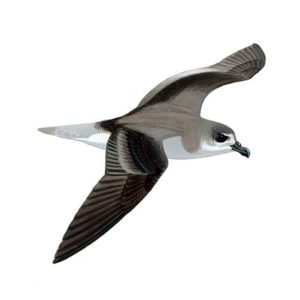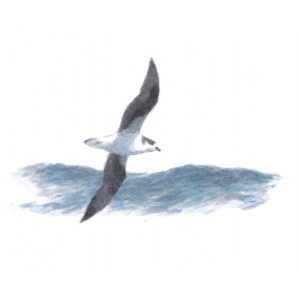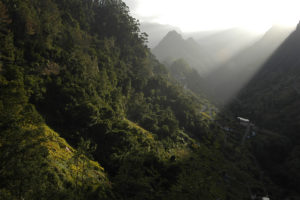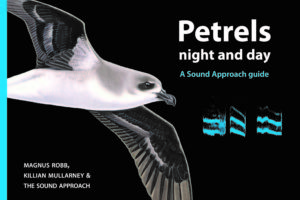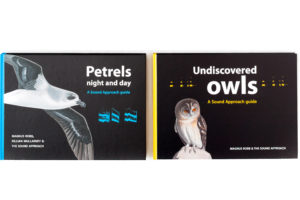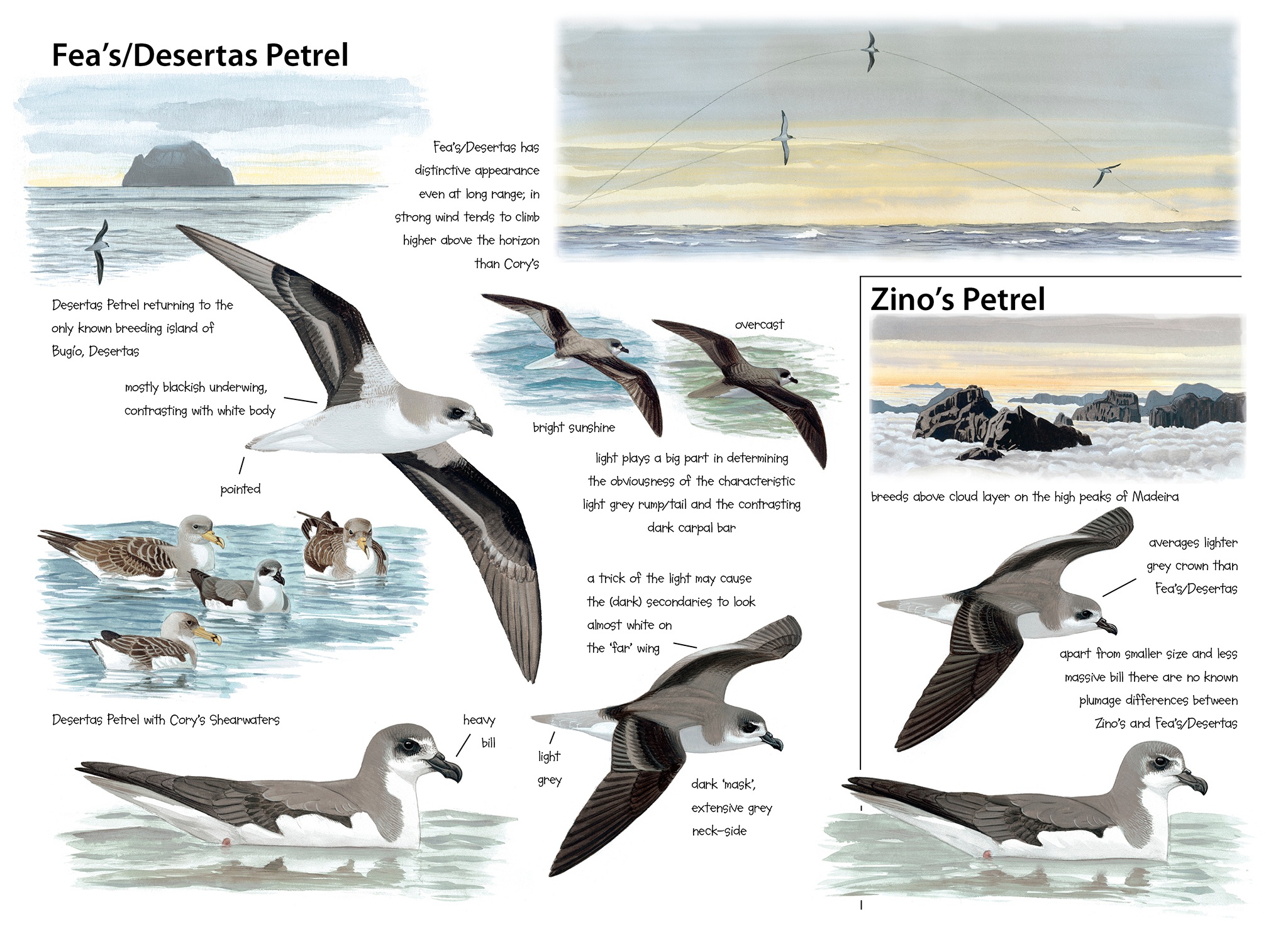
Killian Mullarney
Text by Magnus Robb.
Pico do Areeiro, the highest point on Madeira, casts a long shadow over a sea of clouds, all the way to the eastern horizon. The wind and cold up top are quite a shock after the late afternoon warmth of Funchal, the island’s capital and main harbour. Our guide, João Nunes, has been answering our questions all the way along the road winding up through the forest. Now he issues torches, and we all rush to put on warm clothing. We have come to visit a colony of Zino’s Petrel Pterodroma madeira, one of the rarest seabirds in the world. There are only about 65-80 pairs, and the entire population cannot be more than a couple of hundred individuals. During the day they feed at sea, and it is only at night that the breeding grounds come alive. Only two colonies are known, and both are in the highest mountains of Madeira, nearly 2000 m above sea level.
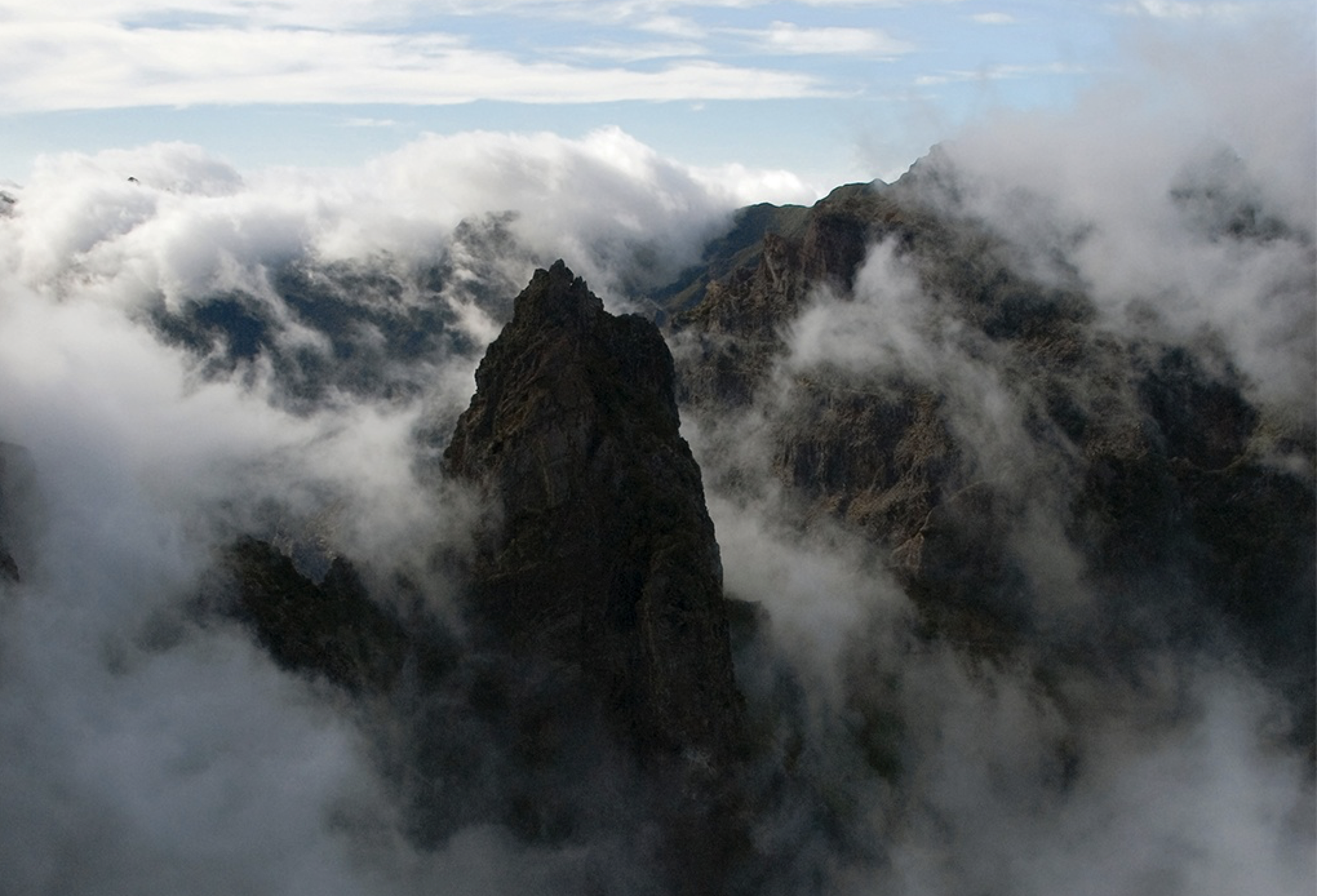
Breeding habitat of Zino’s Petrel Pterodroma madeira, Pico do Areeiro, Madeira, September 2005 (Jacob Gonzáles-Solís).
The sun has already set as we head out along the narrow path, following a ridge sloping gradually down from the top. Madeiran Bats Pipistrellus maderensis are already out and about, and Plain Swifts Apus unicolor call from their roost in a crevice. The track continues along a ledge under an overhanging cliff. Opening a sturdy gate, we enter an area protected from grazing, where the night air is full of the scent of endemic mountain herbs. We round a sharp bend, and the path continues up bare rocks and over another small peak, where a whiff of something fishy tells me that we have reached our destination. In the dark, a narrow ridge is barely discernable, just wide enough for us to cross in single file. João warns us that part of the railing is missing. Darkness and a cushion of clouds hide the precipitous depths below. Years ago, my friend George Sangster suffered vertigo here, and it has stayed with him ever since. It is new moon, and only the wind and an occasional shooting star move. We stand completely still in the darkness, listening.
At first all we can hear is the wind. The moan of a distant goat fools us for a moment. Then something swishes through the air not far above us, a sound more musical than the wind. This is followed by the beating of wings, and we know that the first Zino’s Petrel has arrived. Numbers build up gradually and, after midnight, activity is in full swing. The slow, haunting moans you can hear in CD1-01 are songs of the petrels. Some seem to pass barely a few metres above our heads, shredding the wind with their wings; others call from cliff faces in the clouds below.
CD1-01: Zino’s Petrel Pterodroma madeira Pico do Areeiro, Madeira, 00:36, 25 June 2006. About eight individuals displaying in the airspace above one of the two known colonies. 060625.MR.03650b.22
We can see almost nothing. At most, a petrel eclipses a few stars as it whizzes past. Respecting João’s wishes, none of us tries to spotlight them with torches. We would not want a dazzled Zino’s Petrel on our conscience, disoriented and crashing into the rocks. If we had been able to see them, these Zino’s would have looked like a slightly smaller version of Desertas Petrel P deserta, breeding only 55 km away on Bugio, the southernmost island of the Madeiran archipelago. And Desertas is, in turn, almost identical to Fea’s Petrel P feae breeding in the Cape Verde Islands 2000 km to the south. Petrels of the genus Pterodroma are famed for the dramatic way they fly in strong winds, looping high above wave crests in great twisting arcs. The name gadfly petrel was inspired by their tremendous speed. ‘Gadding about’ means wandering around in a devil-may-care, reckless pursuit of pleasure or entertainment, and Oestrelata, the original genus name, came from the Greek word oistrelatos meaning ‘goaded by a gadfly’ (Warham 1990).
When Gregory Mathews formally described the petrel breeding in the mountains of central Madeira (1934a, 1934b), he classified it, along with Desertas and Fea’s Petrels, as a subspecies of the similar-looking Soft-plumaged Petrel P mollis of the southern oceans. This view prevailed for 50 years, and even today lucky seawatchers often prefer to say they have seen a ‘soft-plumaged petrel’, rather than claim something more specific. Recent DNA research has shown that this taxonomy is wrong; the closest relatives of Desertas, Fea’s and Zino’s Petrels are not in the southern oceans, but on the other side of the North Atlantic (eg, Nunn & Stanley 1998, Penhallurick & Wink 2004). Vocalisations and DNA put them nearer to Cahow P cahow, restricted to Bermuda, and Black-capped Petrel P hasitata of the Caribbean.
How Zino’s Petrel became disentangled from Desertas and Fea’s Petrels is fascinating. In 1903, a German priest, Ernesto Schmitz, became the first ornithologist to see one alive, although he did not recognise it as different from the gadfly petrel breeding on Bugio in the nearby Desertas. When Schmitz left the archipelago in 1908, the breeding localities were forgotten, and over the course of several decades, fears grew that the population might have become extinct. Only finds of fledglings in October of 1940 and 1951, disorientated by the lights of Funchal on their first glide down to the sea, reassured ornithologists that a breeding population still existed.
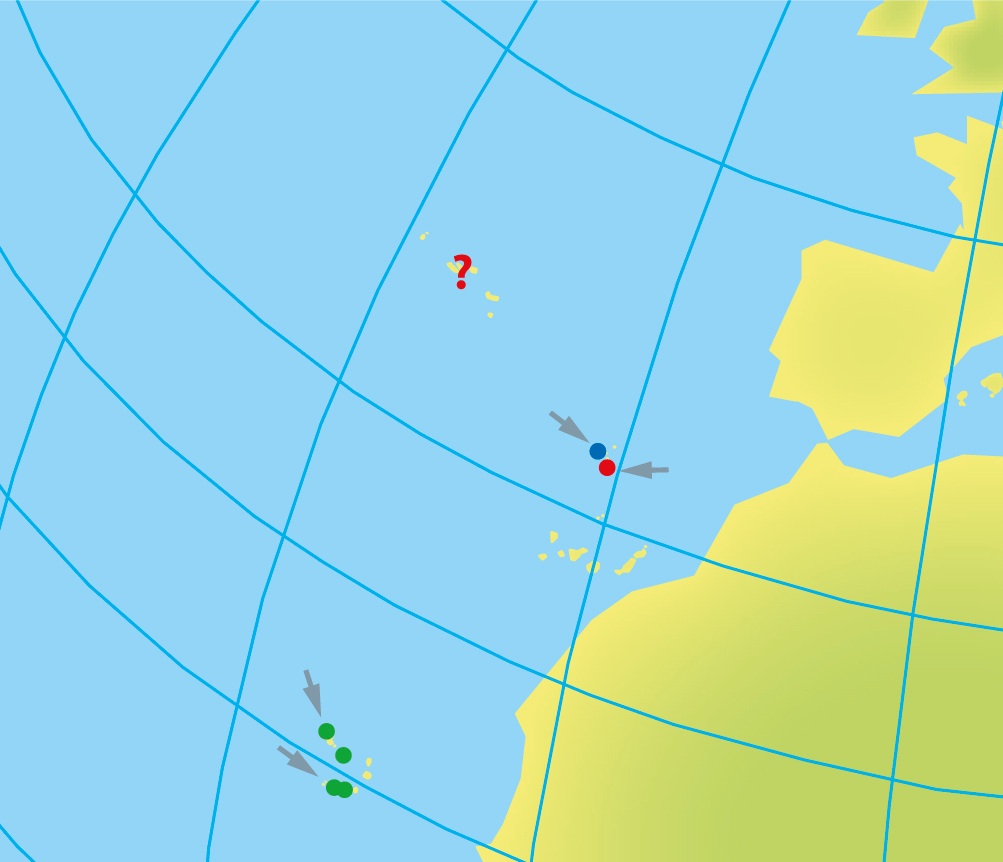
Gadfly petrels: known breeding distribution.
Recording locations indicated by arrows.
Blue: Zino’s Petrel Pterodroma madeira. Recordings: Pico do Areeiro, Madeira.
Green: Fea’s Petel Pterodroma feae. Recordings (north to south): Chã Dura, Santo Antão, Cape Verde Islands; Bangueira, Fogo, Cape Verde Islands.
Red: Desertas Petrel Pterodroma deserta. Desertas Petrel is also suspected to breed in the Azores, although this has never been proven. Recordings: Bugio, Desertas, Madeira.
In 1963 a scientific expedition to the Selvagens was organised by Günther Maul of the Funchal museum. Among its participants were two French ornithologists, Christian Jouanin and Francis Roux, and two inhabitants of Funchal, Paul Alexander (‘Alec’) Zino and his son Francis (‘Frank’). At that time Alec worked in the property business his family had built up, and Frank later became a doctor. The trip to the Selvagens in 1963, and in particular the example of Christian and Francis, inspired both Zinos to become ornithologists. They made several expeditions to Bugio, and during one of these, excellent recordings of Desertas Petrels were obtained (CD1-10 & CD1-11).

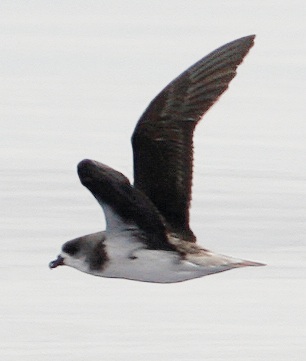
Apparently small-billed gadfly petrel, possibly Zino’s Petrel Pterodroma madeira, with Cory’s Shearwaters Calonectris borealis, and in flight, Deserta Grande, Desertas, Madeira, 30 June 2006 (Killian Mullarney). While it may be reasonably ‘safe’ to identify clearly large-billed gadfly petrels in Madeiran waters as Desertas Petrel P deserta, the converse, that small-billed birds must be Zino’s Petrel is more difficult to prove.
On reflection, Alec realised that there was a good chance the petrels of the lost Madeiran population might have very similar sounds. If he played the recordings to people living high in the mountains, they might tell him where to look. A shepherd, Lucas, said he had heard very similar calls above Curral das Freiras, in the area first described by Schmitz. Here is the story in Alec and Frank’s own words, from a paper they published in 1986:
“On 17 May 1969 a search party led by Lucas was organized to cover the area he had described and strict instructions were given to all four men that if nests were found, on no account was any bird to be disturbed or any egg taken. The search was not conclusive for the men found several nest burrows, apparently fresh, but no eggs or birds were present. The ledges where they were found could only be reached by rope and were thus similar in this aspect to those which had been described by Schmitz.”
“On 15 June 1969, upon our return from the Salvage Islands, we were informed that a visiting ornithologist had organized the same men as had searched the mountains in May and that the same area was going to be searched again the following day. On 16 June we were informed by phone that the birds had been found. We hurried to the spot where to our horror we found that the men had collected from a single breeding site 8 live birds and 6 eggs. We tried to persuade the ornithologist to return all birds and eggs and it was finally agreed that 2 birds and 2 eggs would be kept, the rest would be returned to their nests.”
“We set off with the men and when the spot where the birds had been found was reached, we looked down a cliff which fell away to a depth of several hundred metres. A ledge about 60 m perpendicularly below was pointed out as the breeding site. As the men prepared to lower one of their companions down the cliff on a rope, it started to rain. The rain increased and the men were very weary, so the operation was called off. The six birds were released and the eggs handed to the ornithologist with a request that one be handed to the Funchal Museum and one to us.”
It was curious that the Zinos chose not to name the villain of this story. In May 2007, when I asked Frank if the time had come for him to be ‘named and shamed’, he still preferred to avoid the question: “If I say he was a French priest and a really great person to meet and talk to, you may get the message”. Frank told me more about the anonymous rogue: “I know that he went to Mauritania on occasions, and every morning he said Mass, setting up an altar wherever he was. On top of the altar was a loaded 12 bore and God help any rare bird that flew over during Mass!”

Zino’s Petrel Pterodroma madeira, Pico do Areeiro, Madeira, 28 July 2004 (Frank Zino / Freira Conservation Project)
Only one man fits the bill, the Abbé René de Naurois, who died on 12 January 2006 at the age of 99. A Zino’s Petrel egg in the American Natural History Museum which he collected on 16 June 1969 puts this beyond doubt. A note with it says “until I found these birds, they were thought to be extinct”. Now there’s a true collector! Despite the Abbé’s misdemeanours, Frank’s affection for him was shared by many. The long series of papers he published about birds of the Cape Verde Islands are a treasure, and in 1995, Cornelis Hazevoet dedicated The birds of the Cape Verde Islands to him, saying he had “done more for Cape Verde ornithology than anyone else”. In France, the Abbé is better known as a hero of the resistance, saving the lives of Jews during the second world war.
Since 1969, the Zinos have worked tirelessly to protect the petrel whose breeding grounds they rediscovered. Besides collectors, the main enemies of the birds are introduced mammals. In 1985, rats were such a problem, eating eggs and chicks, that not one petrel was known to have fledged. In 1986, the Freira Conservation Project (FCP) was set up and with the help of Alan Buckle, a world renowned expert on rats, intensive poisoning was started using a series of “cordons sanitaires” with specially designed boxes and Klerat as bait. In 1991, cats destroyed 10 adults on a single ledge. Immediately, the FCP initiated a Cat Control program, with excellent results. As recently as the late 1990s, only about 20 pairs of Zino’s Petrels were thought to survive. The breeding population and its productivity were monitored more closely. Known breeding pairs increased to 29 in 2000, and then in 2004 a second colony was discovered, bringing the total up to the current estimate of 65-80 pairs.

Zino’s Petrels Pterodroma madeira, Pico do Areeiro, Madeira, 11 July 2005 (Frank Zino / Freira Conservation Project)
People unfamiliar with their traditions must think ornithologists are a pretty vain lot. One could easily assume that ornithologists of the past, not happy with blasting everything out of the sky, smugly named their discoveries after themselves. But this is not the way it works. In the case of Pterodroma madeira, the Zinos favoured the name Madeiran Petrel. But unfortunately, this invited confusion with Madeiran Storm Petrel Oceanodroma castro. In 1993, Bourne and Casement proposed the name ‘Zino’s Petrel’ in recognition of the family’s rediscovery of the species, and their outstanding contribution to its preservation. Nobody could argue with that, and the name has stuck. I never met Alec Zino, who died in 2004, although I once heard him telling the story of the rediscovery on the BBC World Service. Frank is very active in conservation of the ‘freiras’, and I have been fortunate to meet him several times.
Relatively little is known about the natural history of Zino’s Petrel, because, apart from its rarity, behavioural studies are not straightforward on almost sheer cliffs in the dark. Some other gadfly petrels breeding at less difficult sites have been studied in more detail. One thing they all share is that calling at the colonies takes place mainly during aerial displays. Flight is almost effortless for gadfly petrels, especially when, like Zino’s, they enjoy strong updrafts from cliffs. Their agility means that calling in flight involves little risk from predators in the air.
The most dramatic part of gadfly petrel courtship is when they perform high speed pursuit flights. Groups of two or more birds chase each other back and forth along the cliff tops like great nocturnal swifts. Wingate’s (1964) description of Black-capped Petrels seen by moonlight flying over Haiti could apply equally well to Zino’s Petrel. “On one such occasion it was possible to see the birds silhouetted against the tops of clouds. These were flying back and forth along the cliffs on steadily beating wings and occasionally formed paired flights or tight groupings of up to six individuals during which ecstatic calls were uttered.” Listening to the first three recordings on the CD, it is not difficult to imagine pursuit flights going on. At the time these recordings were made, it was so dark that I was unable to see how many birds were involved. Just occasionally, one could make out silhouettes of two birds flying past in close pursuit.
It seems natural to assume that pursuit flights often involve one bird of each sex. This has never been proven beyond question for any gadfly petrel, but is suggested by several clues. At Midway Atoll in the Pacific, a form of slow chasing has been observed in courting pairs of Bonin Petrel P hypoleuca on the ground. One bird followed close on the tail of the other as they meandered within a small area. When chases ended in copulation, the pursuer was the one on top. Based on these observations, different calls for male and female Bonin Petrels could be inferred, and these could be heard in flight as well as on the ground. The female’s calls were harsher than the male’s, which were higher pitched with a clearer sound (Grant et al 1983). This is now known to be the same in most petrel species.
Bretagnolle (1995) has published the only analysis of Zino’s Petrel sounds, which was intended to clarify its taxonomic relationships: “Calls, owing to their role in species-specific recognition in these birds, should be given priority over other characters for species separation”. All the species he compared – Soft-plumaged, Desertas, Fea’s, Zino’s, Cahow and Black-capped Petrels – have long, mournful sounding moans. Wingate (1964), writing about Cahow and Black-capped Petrel moans, divided them into low and high types, and Bretagnolle did the same. He went on to speculate that low and high moans (which he called type 1 and 2, respectively) represented calls of the two different sexes. On this point I am inclined to agree.
However, I believe that Bretagnolle misunderstood one aspect of gadfly petrel sounds, which could have had serious consequences for Zino’s Petrel, and the efforts being made to save it. To explain, I will need to give a quick lesson in reading sonagrams. These graphic representations of sounds, where frequency is plotted against time, are read from left to right like music. The higher a dark trace appears in the graph, the higher its frequency or pitch. Zino’s moans have a descending pitch, so in sonagrams they slope downwards from left to right. You can see this in a sonagram made from the start of CD1-02, in which you can hear a Zino’s giving two high-type moans as it hurtles past. This recording was made on a second visit, when we returned to the colony with Frank Zino and his wife Buffy. The plan was to catch and ring any birds hitting a series of mist nets stretched along the top of a narrow ridge. Unfortunately we were not in luck.
CD1-02: Zino’s Petrel Pterodroma madeira Pico do Areeiro, Madeira, 00:25, 03 July 2007. Moaning calls of at least two individuals in display flight close to their breeding ledges. Most calls shown in the sonagram, including the first two, are of the high type (probably male). 060703.MR.02523.11
Besides their descending pitch, the sonagram shows another interesting aspect of Zino’s Petrel moans. See the wavy pattern in the first moan? This corresponds to a ‘vibrato’ quality you can hear in the sound, which is called frequency modulation. Wingbeats, powered by massive contractions of the breast muscles, can sometimes have this effect on the voice. A Com-mon Buzzard Buteo buteo speeding away from its nest, for example, will give a wavering version of its mewing call. In CD1-02, you can see and hear that in Zino’s too, modulation and wingbeats are connected. The first moan has very clear modulations at a rate of about seven or eight per second, and the indistinct vertical bars behind them are wingbeats at exactly the same speed.
A bird sound is typically composed of several different frequencies at once, which we normally perceive as a single sound. You can see them as several different layers in the sonagram, one on top of the other. All of these contribute to the tonal quality or ‘timbre’ of the sound. The lowest, usually showing as a thicker band in a sonagram, is called the fundamental. Weaker bands above it are known as harmonics, and they appear at exact multiples of the fundamental frequency (which also counts as the first harmonic). In this sonagram, you can see harmonics at exactly two and three times the frequency of the fundamental.
The next track (CD1-03) starts with a series of both high and low moans at close range. In the corresponding sonagram, taken from the start of the recording, we have coloured the low moans red and the high moans blue, to keep them separate. The time scale in this sonagram is different from the first, to show a longer series of calls. As you can see, low moans have twice as many bands as high ones. Bretagnolle interpreted all the visible bands of low moans as harmonics. The distance between them seemed to imply a missing fundamental at about 310 Hz, which could be doubled, tripled, etc to give all the other bands. When I started looking at Zino’s Petrel low moans myself, trying to work out what Bretagnolle had done, I ran into several problems. Why were all of his fundamentals invisible? Why were there often gaps in the second, fourth and sixth visible layers? And why did extra bands and messy bits often appear towards the end? The answers had to do with chaos theory.
Once you have learned to read the more basic sonagrams, the traces of some sounds, like those of petrels, can sometimes look messy and chaotic. Chaos theory takes what appears to be a random mess, and shows that there is order and a predictable path. Even in the messy parts, there are regular patterns that you can look out for. When an oscillating sound source like a petrel’s syrinx or voice box is subjected to certain stresses, the pitch can change instantaneously, or the sound can suddenly become hoarse from one moment to the next. The wonderful technical term for such an abrupt change is a ‘bifurcation’, and the study of bifurcations in sound is called ‘nonlinear acoustics’. One of the most simple kinds of bifurcation produces additional frequency bands in between the usual harmonics. In birds, these ‘subharmonics’ have only rarely been pointed out (eg, Beckers & ten Cate 2006), and yet they are common, especially in petrel sounds. They have been studied much more thoroughly in mammals (eg, Wilden et al 1998).
We have coloured the subharmonics purple in another sona-gram taken from 15-20 seconds into the same track (CD1-03). As you can see, every second band in low moans is a subharmonic, and they can also appear at the end of high moans. Another kind of bifurcation results in ‘chaos’, which we have coloured green. Chaos sounds harsh or noisy, but differs from true noise in that remnants of harmonics and subharmonics linger in the spectrum. A helpful rule is that bifurcations always work in regular steps. So a simple sound with harmonics has to ‘descend’ one step into subharmonics, before it can ‘descend into chaos’. A sound can step back and forth between these different states, but it cannot skip one.
CD1-03: Zino’s Petrel Pterodroma madeira Pico do Areeiro, Madeira, 00:36, 25 June 2006. Moaning and whimpering calls in display flights above a colony. 060625.MR.03650a.22
Chaos theory helped me to understand that in low moans of Zino’s Petrel, the lowest visible band in sonagrams is the fundamental after all; there is not an invisible one below that. High and low moans actually differ in their fundamental frequency by a fairly small margin, and the big difference between them is the extent of chaos and subharmonics.
While this may sound very academic, Bretagnolle’s analysis led him to recommend a taxonomic change. When he let loose some powerful statistical methods on his data, the wrongly inferred fundamentals in the low moans compromised the results, exaggerating both the similarity of Desertas and Zino’s Petrels’ low moans, and the contrast between them and all the others. His results led Bretagnolle to propose a two way split, with Soft-plumaged Petrel as one species, and Desertas, Fea’s and Zino’s Petrels lumped together as another. Had this taxonomy gained wide acceptance, efforts to conserve Desertas, Fea’s and Zino’s might have been severely compromised. Fortunately it never did.
Zino’s Petrel still has an extremely small population, and the species is classified by BirdLife International as ‘endangered’. A few years ago, a new radar station proposed for the top of Pico do Areeiro seemed to spell doom for the main colony. However, the site of the radar station, which will be completed within a couple of years, is some distance from the colony, and the Freira Conservation Project’s assessment (Frank Zino pers comm) is that it will be much less of a threat than first feared, as long as lighting is kept to a minimum. Actually, there has been more good news than bad in recent years. On Frank’s initiative, the land containing the two colonies has been bought and designated a Special Protection Area. It is now being managed by the Madeira Natural Park. Petrel numbers are increasing, and in 2006 the Freira Conservation Project caught no less than 23 juveniles. There cannot be many species in the world with such a high proportion of ringed individuals.
During their ringing sessions, volunteers of the Freira Conservation Project have often heard an important call type that seems to be particularly prevalent in Zino’s Petrel. In CD1-03, you may have noticed several series of short, high-pitched notes, sounding like the whimpering of a small dog. Frank hears these calls when his petrels hit the nets, but as these recordings show, they can also be heard during pursuit flights. Whimpering calls can also be heard from the ground, where they may indicate the location of a nest. In the next track (CD1-04), you can hear a Zino’s giving a series of these calls, just after it had landed. A quiet, muffled and longer answer can be heard, presumably from inside a burrow.
CD1-04: Zino’s Petrel Pterodroma madeira Pico do Areeiro, Madeira, 00:08, 3 July 2007. Whimpering calls of an individual that had just alighted near a burrow; a reply can be heard from another inside. 060703.MR.00824.31
Calling Zino’s Petrels can be heard at Pico do Areeiro on most nights from late March until at least late August, with a peak from May to July. In late March and especially the first week of April, returning adults spring-clean their nests. Then, after a pre-laying exodus, eggs are laid in late May or early June. They hatch in late July or early August, and the young fledge during the first three weeks of October. Despite their incredible rarity, any keen birder can go and listen to Zino’s on their breeding grounds. However, it is illegal to enter the area after dark unless you are accompanied by a guide and possess an official permit. Guides are available between mid-May and mid-August, and I strongly recommend going with one (see http://madeira.seawatching.net for links to companies currently offering trips). That way you will go straight to the right spot, cause a minimum of disturbance to the birds, and you can learn much more than you would otherwise. More colonies may yet be discovered in parts of the central Madeiran mountains where nobody goes at night. Finding them will be a job for adventurous spirits with a good ear, and no fear of darkness or heights.

